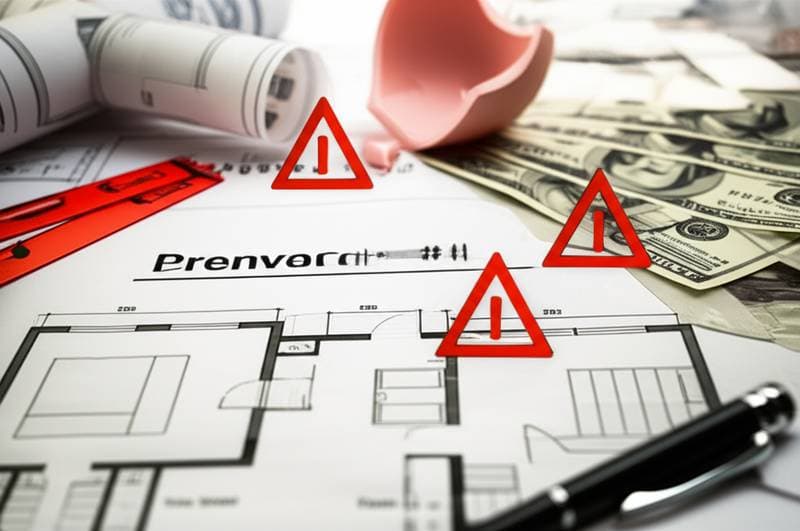Spot Contractor Red Flags in 2025 to Avoid Paying 42% More
A recent HomeAdvisor report on homeowner confidence reveals that nearly 42 percent of renovation clients encounter at least one financial dispute with a contractor. Among those instances, 63 percent stem from unclear payment terms or undocumented cost overruns. These statistics underscore the challenges homeowners face in managing renovation budgets amid a tightening contractor market and fluctuating material costs. Recognizing early warning signs before any payment proves essential to sidestep financial pitfalls.
This guide details how to identify key contractor red flags prior to payment. Insights from financial planners, project managers, and licensed contractors who have observed these problems directly inform the recommendations.
1. Excessive Upfront Deposits
The Issue
Requests for substantial deposits before work commences often indicate financial instability or scam potential. The National Association of Home Builders states that reputable contractors request 10 to 25 percent upfront, varying by project scale and complexity. Amounts exceeding one-third suggest cash flow issues or inadequate business practices.
Expert Perspective
Linda Barrett, a certified financial consultant with 18 years advising homeowners on renovation loans, notes, "When a contractor asks for more than one-third upfront, the homeowner is carrying the project’s financial risk. This is never a good position for the client."
Professional remodelers prefer milestone-based payments linked to specific achievements, such as framing completion, rough-in inspections, or cabinetry installation. This approach fosters accountability and clarity.
Steps to Take
Establish written payment milestones. Verify each stage before releasing funds. Use traceable payment methods like bank transfers or checks, avoiding cash entirely. Maintain records of invoices, receipts, and signed approvals.
Financial Impact
Structured payments until milestones reduce risks of incomplete work. Homeowners enforcing such schedules save 8 to 12 percent on dispute costs, per Porch.com’s contractor satisfaction survey.
2. Absence of Detailed Contracts
The Issue
Contractors who sidestep comprehensive paperwork pose significant financial risks. A written contract serves as the primary safeguard against inflated costs, timeline conflicts, or unfinished projects.
Expert Perspective
Mark Jensen, project manager at BuildSure Consulting, states, "A solid contract defines scope, materials, and payment benchmarks. Without it, you have no enforceable framework if something goes wrong."
Legitimate contractors provide detailed proposals with breakdowns for materials, labor, permits, and contingencies. Vague phrases like "as needed" or omitted line items frequently hide additional charges.
Steps to Take
Refuse to begin without a signed, itemized contract. Demand line-by-line pricing for materials and labor. Document, price, and approve all change orders in writing prior to implementation.
Resistance to providing details signals a major concern. Demand full transparency as a baseline requirement.
Financial Impact
Disputes from ambiguous contracts can increase project costs by 20 to 35 percent. Investing a few hundred dollars for attorney or advisor review of the contract averts potential thousands in losses.
3. Bids That Appear Unbelievably Low
The Issue
A bid significantly below competitors often points to shortcuts, unlicensed workers, or strategies to win the job through underbidding.
Expert Perspective
The Remodeling Cost vs. Value report indicates that competitive bids for identical projects vary by no more than 15 percent. Deviations below this level require close examination.
Construction analyst Peter Kim of NorthBridge Estimating observes, "Lowball bids often omit essential details like disposal fees, permits, or material quality. Once the homeowner is locked in, those missing costs appear as ‘unexpected extras.’"
Steps to Take
Evaluate multiple bids side by side, ensuring comparable specifications. Require details on brands, quantities, and methods from each contractor. For notably lower bids, seek written justifications.
Credible professionals explain cost reductions through verifiable advantages, such as bulk purchasing, rather than vague promises.
Financial Impact
Selecting the lowest bid without scrutiny negates initial savings. Research indicates that 64 percent of homeowners choosing the cheapest option incur higher expenses from corrections or add-ons.
4. Lack of Licensing, Insurance, or Permit Documentation
The Issue
Unlicensed contractors evade regulatory standards, shifting liability for accidents, damage, or code breaches onto homeowners.
Expert Perspective
Licensed professionals must hold liability and workers’ compensation insurance. Absence of these protections exposes homeowners to substantial legal and medical costs from injuries.
The Insurance Information Institute reports that a single injury claim against an uninsured party can exceed $30,000 in damages for the homeowner.
Steps to Take
Confirm licensing through your local building authority. Request insurance proofs, including policy numbers and expiration dates, then verify active coverage with the provider.
Professionals readily supply this information. Deflection or delays warrant immediate withdrawal.
Financial Impact
Initial savings of 10 percent from unlicensed hires pale against potential tenfold increases from failed inspections or damage repairs. The long-term risks outweigh short-term gains.
5. Inconsistent Communication and Schedule Changes
The Issue
Unreliable communication, missed meetings, or frequent timeline adjustments foreshadow poor project oversight. Such disarray directly contributes to budget excesses.
Expert Perspective
Project scheduling expert Maria Leone from PlanTrack Construction Systems explains, "Contractors who lack scheduling tools or formal communication systems often struggle to coordinate subcontractors and materials. That inefficiency drives costs higher."
Skilled contractors employ digital tools for progress tracking and regular client updates.
Steps to Take
Inquire about schedule and communication management practices. Insist on weekly updates covering progress, budget, and timelines.
Favor contractors using written logs or digital platforms over verbal reports alone.
Financial Impact
A Fixr study links poor communication to average 9 percent budget overruns. Regular reporting identifies minor problems early, preventing costly delays.
6. Reluctance to Share References or Past Work
The Issue
Reliable contractors document completed projects and client successes. Evasiveness about references or samples arouses suspicion.
Expert Perspective
Bryan Ellis, a licensed general contractor with 25 years of experience, asserts, "Reputable builders rely on referrals and repeat business. If a contractor avoids references, it usually means they have something to hide."
Online reviews complement but do not substitute for direct references. Verify that cited projects align with the contractor’s license and business identity.
Steps to Take
Solicit three recent references including contact information and project overviews. Contact clients to assess satisfaction, budget adherence, and communication.
Inspect a finished project onsite if feasible to evaluate quality and materials.
Financial Impact
Reference checks mitigate up to 15 percent in rework expenses from subpar work or materials. Basic due diligence preserves significant funds.
7. Aggressive Sales Pressure
The Issue
Urgent demands for deposits or expiring deals employ manipulation over genuine negotiation, often signaling desperation.
Expert Perspective
Consumer protection agencies caution against time-bound offers in home improvement. Ethical contractors allow time for bid reviews, comparisons, and financing arrangements.
Financial planner Alan Rivera of HomeBudget Advisors states, "Pressure tactics are incompatible with transparent pricing. The contractor should empower the client, not rush them."
Steps to Take
Evaluate bids deliberately without haste. Request estimates valid for a reasonable duration in writing. Reject proposals demanding same-day decisions or payments before contract examination.
Financial Impact
Victims of pressure tactics frequently forfeit deposits to vanishing contractors. The Federal Trade Commission estimates annual losses from such fraud exceed half a billion dollars.
8. Unverifiable Business Details
The Issue
Inconsistent online presence or credentials, such as absent addresses, untraceable contacts, or name variations, question legitimacy.
Expert Perspective
Established businesses exhibit uniform branding and confirmable details. They appear in directories, hold tax IDs, and join groups like the National Association of the Remodeling Industry.
Construction compliance auditor Dana Crowe warns, "A contractor who changes business names frequently may be avoiding bad reviews or legal actions. Always cross-check credentials before signing."
Steps to Take
Validate business registration via state licensing boards. Search legal databases for complaints or judgments under the company name.
Obtain and confirm the tax ID and address through official sources.
Financial Impact
Unverified contractors often forgo insurance, warranties, or accountability. Mid-project abandonment complicates fund recovery.
Secure Your Renovation Success
Selecting a contractor involves financial prudence and oversight. The ideal partner delivers organization, responsibility, and tangible benefits to your project. A poor choice erodes budgets, extends timelines, and harms property value.
Prior to any payment, authenticate credentials, secure thorough documentation, and enforce milestone payments. Engage financial advisors, project managers, or construction attorneys for contract and budget reviews.
Implementing these practices not only thwarts scams but also empowers homeowners with greater influence over costs and results. Early detection of red flags safeguards finances and enhances the home improvement experience.




